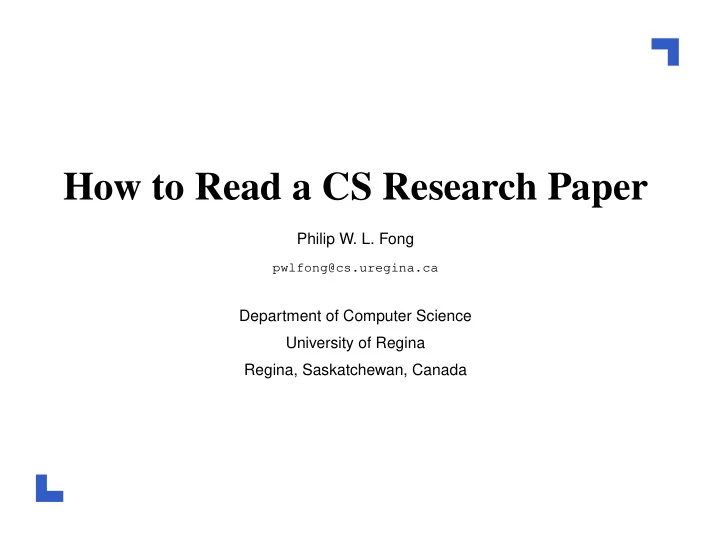

How to Read a CS Research Paper Philip W. L. Fong pwlfong@cs.uregina.ca Department of Computer Science University of Regina Regina, Saskatchewan, Canada
Classification of Research Papers Workshop Papers: Work in progress, ideas, position papers Conference Papers: Refereed research results Journal Papers: Archival quality research results Technical Reports: Not refereed; companion to conference/journal paper Dissertatation: Not refereed; but usually has external examiner How to Read a CS Research Paper – p.1/9
Picking the Right Paper to Read NO magazine articles please High quality conference or journal publications Example: consult IEEE/ACM portal Using the library website Talk to your mentor or seminar coordinator Proper citation How to Read a CS Research Paper – p.2/9
Reading a Research Paper 1. Comprehension 2. Evaluation 3. Synthesis How to Read a CS Research Paper – p.3/9
Step 1: Comprehension Decoding the plot of a paper: 1. What is the research problem the paper attempts to address? 2. What are the claimed contributions of the paper? 3. How do the authors substantiate their claims? 4. What are the conclusions? ▽ How to Read a CS Research Paper – p.4/9
Step 1: Comprehension Decoding the plot of a paper: 1. What is the research problem the paper attempts to address? What is the niche? 2. What are the claimed contributions of the paper? 3. How do the authors substantiate their claims? 4. What are the conclusions? ▽ How to Read a CS Research Paper – p.4/9
Step 1: Comprehension Decoding the plot of a paper: 1. What is the research problem the paper attempts to address? What is the niche? 2. What are the claimed contributions of the paper? What is original? 3. How do the authors substantiate their claims? 4. What are the conclusions? ▽ How to Read a CS Research Paper – p.4/9
Step 1: Comprehension Decoding the plot of a paper: 1. What is the research problem the paper attempts to address? What is the niche? 2. What are the claimed contributions of the paper? What is original? 3. How do the authors substantiate their claims? What makes the claims scientific? 4. What are the conclusions? ▽ How to Read a CS Research Paper – p.4/9
Step 1: Comprehension Decoding the plot of a paper: 1. What is the research problem the paper attempts to address? What is the niche? 2. What are the claimed contributions of the paper? What is original? 3. How do the authors substantiate their claims? What makes the claims scientific? 4. What are the conclusions? What are the lessons? ▽ How to Read a CS Research Paper – p.4/9
Step 1: Comprehension Decoding the plot of a paper: 1. What is the research problem the paper attempts to address? What is the niche? 2. What are the claimed contributions of the paper? What is original? 3. How do the authors substantiate their claims? What makes the claims scientific? 4. What are the conclusions? What are the lessons? How to Read a CS Research Paper – p.4/9
Step 2: Evaluation 1. Is the research problem significant? 2. Are the contributions significant? 3. Are the claims valid? ▽ How to Read a CS Research Paper – p.5/9
Step 2: Evaluation 1. Is the research problem significant? Is the work scratching minor itches? 2. Are the contributions significant? 3. Are the claims valid? ▽ How to Read a CS Research Paper – p.5/9
Step 2: Evaluation 1. Is the research problem significant? Is the work scratching minor itches? 2. Are the contributions significant? Are there genuine surprises? 3. Are the claims valid? ▽ How to Read a CS Research Paper – p.5/9
Step 2: Evaluation 1. Is the research problem significant? Is the work scratching minor itches? 2. Are the contributions significant? Are there genuine surprises? 3. Are the claims valid? Have the authors been cutting corners? ▽ How to Read a CS Research Paper – p.5/9
Step 2: Evaluation 1. Is the research problem significant? Is the work scratching minor itches? 2. Are the contributions significant? Are there genuine surprises? 3. Are the claims valid? Have the authors been cutting corners? How to Read a CS Research Paper – p.5/9
Step 3: Synthesis What is the crux of the research problem? What are some alternative approaches to address the research problem? What is a better way to substantiate the claim of the authors? What is a good argument against the case made by the authors? How to Read a CS Research Paper – p.6/9
Step 3: Synthesis How can the research results be improved? How can the research results be applied to another context? What are the open problems raised by this work? Bottomline: Can we do better than the authors? How to Read a CS Research Paper – p.7/9
Paper Review 2–4 pages in length: 1. Abstract 2. Evaluation 3. Synthesis How to Read a CS Research Paper – p.8/9
Professional Paper Review Refereeing process Ian Parberry. A guide for new referees in theoretical computer science. Information and Computation , 112(1):96–116, 1994. Alan Jay Smith. The task of the referee. IEEE Computer , 23(4):65–71, April 1990. How to Read a CS Research Paper – p.9/9
Recommend
More recommend